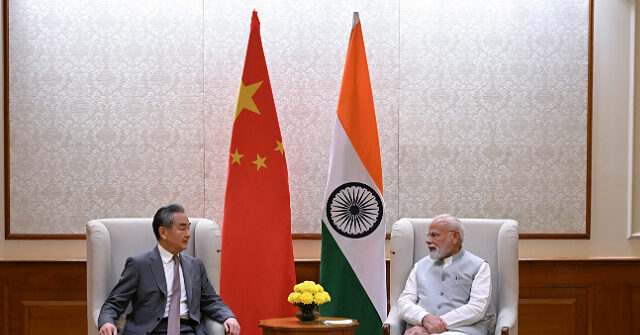Chinese Foreign Minister Wang Yi concluded a brief visit to New Delhi on Wednesday in which he emphasized to senior officials in the Indian government Beijing’s desire to see the two countries “strengthen confidence, move toward each other, overcome disruptions, expand cooperation and consolidate the positive momentum in improving bilateral relations.”
China and India have struggled to maintain friendly relations throughout the past decade as the Chinese Communist Party has repeatedly claimed sovereign Indian territory, sending People’s Liberation Army (PLA) soldiers to establish positions on Indian territory and renaming Indian land using Mandarin names. India has consistently protested the practice and, on occasion, used its military might to oust invading Chinese forces. The most prominent such episode occurred in June 2020, when Indian troops ousted the PLA from the Galwan Valley area of Ladakh, reportedly killing twice as many soldiers as they lost in the first exchange of gunfire in decades.
The two countries, both members of the anti-American BRICS coalition, have since endeavored to restore bilateral trust. Wang and Chinese state media described the foreign minister’s visit this week as primarily centered around discussing and resolving border disputes. Also on the agenda, however, are the difficulties both China and India are experiencing in negotiating a new trade agreement with President Donald Trump. Trump announced a total overhaul of American trade policy in April, requiring the country’s top trade partners to negotiate a deal more favorable to American producers or accept significant tariffs.
Talks with both India and China have stalled, though China appears to be making more progress in establishing an agreement. The Trump administration announced on August 11 that the deadline for imposing tariffs or reaching an agreement would be extended for 90 days, allowing both sides to continue brokering a deal through November. India, in contrast, is already paying a 50-percent tariff on exports to the United States. Trump doubled the initial 25-percent tariff in August as a statement against India’s prodigious purchases of sanctioned Russian oil, which he complained hurt the White House’s attempts to bring an end to Russia’s invasion of Ukraine.
Wang appeared to acknowledge the tension between India and America in comments he made during a meeting with Indian External Affairs Minister S. Jaishankar on Monday.
“In today’s world, the century-long transformation is accelerating,” Wang declared, according to China’s state-run Global Times propaganda outlet. “Unilateral bullying practices are on the rise, while free trade and the international order face severe challenges.”
“Both China and India should strengthen confidence, move toward each other, overcome distractions, expand cooperation, and consolidate the positive momentum of improving bilateral relations,” Wang reportedly said. “The revitalization of the two great Eastern civilizations should reinforce and complement one another, providing much-needed certainty and stability for Asia and the wider world.”
While the Global Times did not indicate that Wang mentioned America directly, the Chinese Foreign Ministry regularly accused the United States of “bullying” and challenging “free trade.”
Jaishankar, in a message posted on the social media site Twitter, confirmed that he and Wang discussed “trade issues” in addition to the border dispute.
“Highlighted that our relations are best guided by the three mutuals — mutual respect, mutual sensitivity and mutual interest,” Jaishankar wrote. “As we seek to move ahead from a difficult period in our ties, it needs a candid and constructive approach from both sides.”
Wang followed up his meeting with the top diplomat with an in-person engagement with Hindu nationalist Prime Minister Narendra Modi on Tuesday. According to Modi, their conversation centered on “respect for each other’s interests and sensitivities.” Modi recalled that he is planning to visit China for the Shanghai Cooperation Organization (SCO) summit in Tianjin, China, scheduled to begin on August 31.
Wang also held several conversations regarding border disputes with other officials on Tuesday. Speaking to Indian National Security Advisor Ajit Doval, Wang again emphasized the allegedly “turbulent international situation and a series of common challenges” as motivation to bring India and China closer together.
Chinese coverage of Wang’s visit did not mention the United States directly or India’s struggle to broker an agreement on trade with Washington. Both Trump and senior members of his administration have, in the past two weeks, increased the frequency of their public criticism of India, particularly for funding the Russian invasion of Ukraine through oil sales. Publicly available statistics indicate that India is Russia’s top buyer of crude oil, importing 1.5 million barrels per day (bpd) in July. China is second and has reportedly increased its purchases as New Delhi feels pressure to limit its imports.
“Remember, while India is our friend, we have, over the years, done relatively little business with them because their Tariffs are far too high, among the highest in the World,” Trump declared on Truth Social in July, announcing the tariffs on Indian goods. India, he continued, has “always bought a vast majority of their military equipment from Russia, and are Russia’s largest buyer of ENERGY, along with China, at a time when everyone wants Russia to STOP THE KILLING IN UKRAINE.”
On Tuesday, Treasury Secretary Scott Bessent condemned India for “profiteering” off the Ukraine invasion in an interview with CNBC.
“They are just profiteering. They are reselling,” he explained. “This is what I would call the Indian arbitrage — buying cheap Russian oil, reselling it as product.”
“They’ve made $16 billion in excess profits — some of the richest families in India,” the treasury secretary added.
While one of the world’s largest oil refining powers, India does not have enough natural oil resources to fill its refineries, leading it to purchase Russian crude.
While China is also a major purchaser, CNBC reported that Bessent “suggested that Beijing’s imports were less egregious in the eyes of the Trump administration because it was also a major buyer before Russia invaded Ukraine,” while India dramatically increased its imports after the full-scale invasion of Ukraine began in February 2022.

















